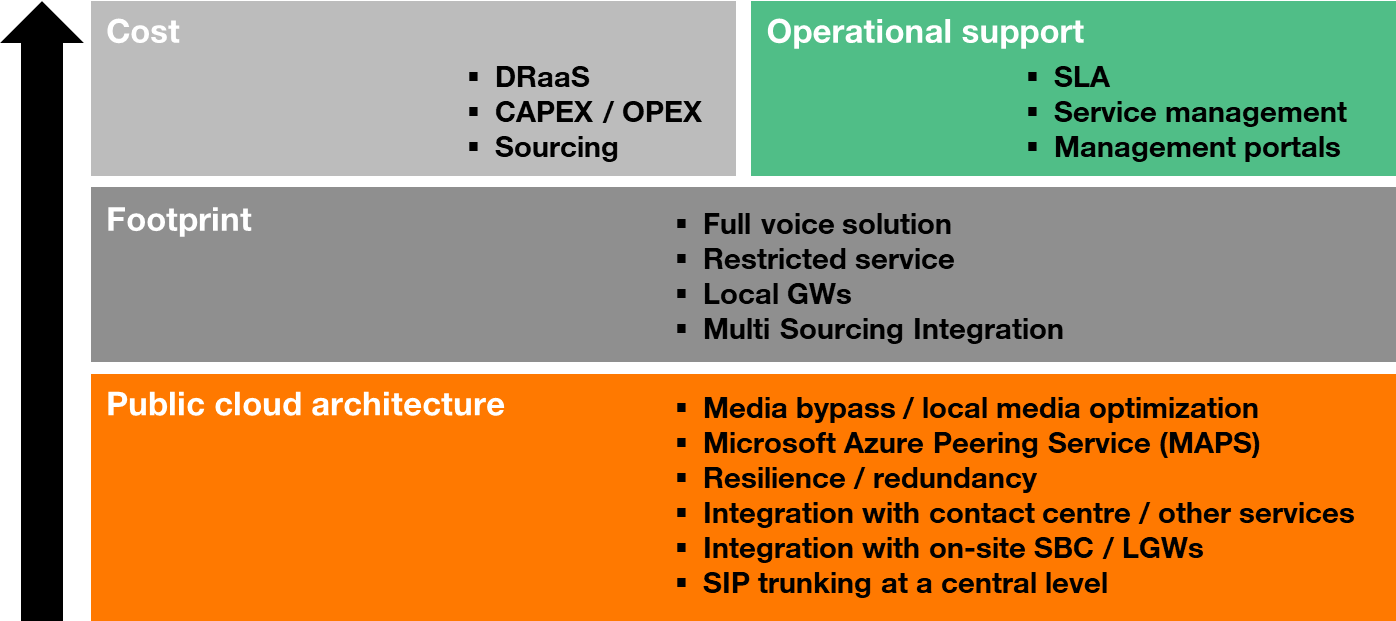In 2017, Microsoft released Teams as an extension of its Office 365 suite. 2018 saw Microsoft begin to encourage customers to interconnect it with the worldwide voice network by implementing direct routing. The first wave of providers included Orange, Swisscom and Telekom Deutschland.
When I talk to customers about direct routing, they often cite different business goals and drivers, different priorities and different requirements. I tell them they need the right sourcing strategy that factors in technical architecture, a service operational model, the provider’s footprint and the commercial imperatives. It’s the route to getting the most out of your direct routing.
1. Pick the right architecture
That means cloud. Cloud is on the rise and is one of the few technologies to emerge from the recent disruption as a success story: Gartner predicts public cloud revenue will grow 6.3% in 2020 to reach total revenues close to $258 billion, up $15 billion on 2019. One of the main reasons for this is a worldwide shift to services delivered from the cloud. The massive working from home (WFH) shift prompted by the pandemic saw enterprises ramp up their use of Microsoft Teams, Zoom, Salesforce and other tools, while at the same time, the consumer market exploded as people locked down at home, enjoying apps like Disney+ and Netflix in unprecedented numbers.
It points to a trend for not having equipment located onsite unless absolutely necessary. Cloud gives enterprises flexibility, control, a subscription-based model that helps with budgets and a continuously renewable infrastructure. A public cloud also means employees can access tools from anywhere on any device, without the need to access the corporate network. Direct routing ties in perfectly with public cloud infrastructure.
Other technical aspects to consider are media bypass and local voice optimization: these two things help you shorten the path of media traffic and reduce the number of hops in transit, giving you better performance, and ensure efficient communication of your media stream. Microsoft Azure Peering Service (MAPS) is valuable if your direct routing provider’s data center is not physically near that of Microsoft, and it is important to remember to integrate with your contact centers, local gateways and centralized SIP trunk. When buying a direct routing service, if you ensure these technical fundamentals are in place, it should not really matter how the internal architecture is built.

2. Define your perimeter
This refers to the area your direct routing needs to cover – where the service extends to geographically. As of August 2020, Microsoft’s calling plan connects employees in nine countries, for example. If your operation is large, it’s worth considering a direct routing provider who can connect employees in around 50 countries. This can be extended further if you connect to a local session border controller (SBC). A local SBC is a less elegant solution than a centralized, cloud-based SBC in your various regions, so it’s worth factoring in the footprint the provider offers when undergoing your direct routing procurement process.
Some customers have spoken to me of their need for a voice service that has no restrictions for employees – for example, the ability to dial out to non-geographical numbers or emergency services from Microsoft Teams. Other companies are content to have some restrictions in place on the service. But again, it is something you need to consider.
Orange provides direct inward dialing (DID) in 51 countries and territories. In other locations, a local SBC can be deployed.

3. Choose a direct routing provider that fits your budget
Some companies have a CAPEX budget they want to allocate at the beginning of a financial year for items like professional services, user adoption training or infrastructure installation. Others prefer the OPEX route to give more control over spending over the course of a financial year. It seems to me that the OPEX model is becoming more of a standard across enterprise initiatives and in our personal lives – consumers might not realize it, but £5.99 for Disney+ and £8.99 a month for Netflix is them paying for entertainment as a service!
The as-a-service (XaaS) model gives you more control over your spending. A consumption-based, direct-routing-as-a-service (DRaaS) model can include a bundle of minutes for voice traffic, much like a mobile phone provider’s flat tariff. This can bring higher initial costs for the buyer, but in exchange, you get better spend predictability. As external voice traffic is diminishing, I expect to see a trend for pay per usage, rather than bundled minutes. Ultimately, global and centralized voice tariffs should help companies realize savings of 40% or more: if they don’t, as one Orange customer told me, “Somebody is not doing their job right!”

4. Future-proof your operational model
Microsoft Office 365 configuration tools can bring benefits, but only really for a small number of employees. For larger numbers of employees in an enterprise, these configuration tools do not scale unless buttressed by PowerShell and Graph API or scripts. For these tools, most companies lack the in-house knowledge and skills to provide operational support. This presents risks. For example, any operational change could require changes to the scripting, and the in-house team simply might not know how to do it.
Management portals can be a big benefit, enabling you to activate user profiles and voice configurations in real time. Online wizards allow you to add or remove voice numbers worldwide in a few seconds and can empower your IT managers to enact dial-plans or disaster recovery policies with a few clicks. Really good wizard portals give you a single point of access and configuration for Office 365 together with voice elements that support direct routing.

Microsoft CEO Satya Nadella said at the end of April 2020 that Microsoft Teams usage had grown 70% to more than 75 million daily active users: an impressive feat in just three years since it launched. Many of my Orange customers have adopted Microsoft Teams as their de facto collaboration platform and are now looking to source direct routing so employees can use Teams as an end-to-end phone system. Providers do vary greatly, so it is important to have the right sourcing strategy in place that incorporates technical architecture, operational model, footprint and budgetary need. Keep these things in mind, and you will enjoy a happy, productive direct routing experience.
If you would like to discuss any issues raised in this blog or for more information on direct routing, please contact me on javier.sanz-blasco@orange.com.

Javier holds an MBA at Henley Business School (UK) and has more than 20 years’ experience in Unified Communications. He currently works as Sales Executive at Orange, where he maps the business requirements of the biggest multinationals to a service. An avid reader and former chess player, he enjoys hiking with his family the mountains of Picos de Europa in Spain and long distance running along the Thames River.